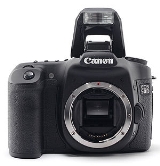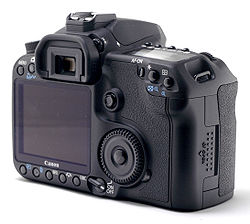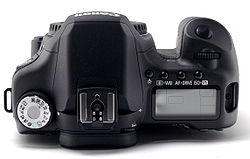
Canon EOS 50D
Encyclopedia
The Canon EOS 50D is a 15.1-megapixel digital single-lens reflex camera
. It is part of the Canon EOS
line of cameras and succeeds the EOS 40D
. In turn, it has been succeeded by the EOS 60D
.
Canon announced the camera on 26 August 2008. The camera was released on 6 October 2008.
.
The 50D has a higher pixel count (15.1 megapixels), hence higher shooting resolutions, than its predecessor and, like the 40D, has a 14-bit RAW format.
The camera has Live View, which allows photographers to use the LCD screen as the viewfinder. Because the sensor mirror needs to be in the locked position (see Live preview
), shutter noise is reduced in this mode. The 50D also has a dedicated LiveView button.

 Changes over the 40D include a higher-resolution sensor (15.1 megapixel instead of 10.1 megapixel).
Changes over the 40D include a higher-resolution sensor (15.1 megapixel instead of 10.1 megapixel).
The sensor also has better noise
control than previous models, although Digital Photography Review
disagrees with that.
The ISO goes up to 3200 in standard mode, and can be increased to 12800 through the use of a custom function. The burst rate
is the same as on the 40D, 6.3 frames per second, though the 40D was advertised as 6.5.
The camera uses Canon's DIGIC 4 image processor. The processor delivers more responsive operation, improved color rendition and near-instant start-up time. A new sensor cleaning system has also been introduced. The camera can also use the Canon Wireless File Transmitter WFT-E3/E3A.
The 50D has a 3" screen – the same size as the 40D – but the resolution is 640×480 pixels, which allows it to show more image detail than any of Canon's previous 3" LCD displays. The 50D features two new Autofocus Modes in Liveview and an HDMI
port.
The 50D is offered as a body only or in a package with a new EF-S 18-200mm 3.5-5.6 IS lens
or EF 28-135 3.5-5.6 IS USM lens
.
es covering the photosensors
. Thus the microlenses are larger, and capture more light and direct it to the sensor sites.
Digital single-lens reflex camera
Most digital single-lens reflex cameras are digital cameras that use a mechanical mirror system and pentaprism to direct light from the lens to an optical viewfinder on the back of the camera....
. It is part of the Canon EOS
Canon EOS
The Canon EOS autofocus 35 mm film and digital SLR camera system was introduced in 1987 with the Canon EOS 650 and is still in production as Canon's current DSLR system...
line of cameras and succeeds the EOS 40D
Canon EOS 40D
The Canon EOS 40D is a 10.1-megapixel semi-professional digital single-lens reflex camera. It was initially announced on August 20, 2007 and was released at the end of that month. It is the successor of the Canon EOS 30D, and is succeeded by the EOS 50D. It can accept EF and EF-S lenses...
. In turn, it has been succeeded by the EOS 60D
Canon EOS 60D
The Canon EOS 60D is a digital single-lens reflex camera from Canon. It is part of the Canon EOS line of cameras and succeeds the EOS 50D. It was publicly announced on August 26, 2010....
.
Canon announced the camera on 26 August 2008. The camera was released on 6 October 2008.
Overview and features
The 50D has many similar characteristics to its predecessor, the 40D. This includes various shooting modes, the ability to change ISO and white balance, a pop-up flash unit, and an LCD screen. The LCD screen is the same size (3.0") as the 40D but has a higher resolution (920k pixels) than any previous model. It is the successor of the Canon EOS 40D, and is succeeded by the EOS 60DCanon EOS 60D
The Canon EOS 60D is a digital single-lens reflex camera from Canon. It is part of the Canon EOS line of cameras and succeeds the EOS 50D. It was publicly announced on August 26, 2010....
.
The 50D has a higher pixel count (15.1 megapixels), hence higher shooting resolutions, than its predecessor and, like the 40D, has a 14-bit RAW format.
The camera has Live View, which allows photographers to use the LCD screen as the viewfinder. Because the sensor mirror needs to be in the locked position (see Live preview
Live preview
Live preview is a feature that allows a digital camera's display screen to be used as a viewfinder. This provides a means of previewing framing and other exposure before taking the photograph. In most such cameras, the preview is generated by means of continuously and directly projecting the image...
), shutter noise is reduced in this mode. The 50D also has a dedicated LiveView button.
- 15.1 megapixel APS-CAPS-CAdvanced Photo System type-C is an image sensor format approximately equivalent in size to the Advanced Photo System "classic" size negatives...
CMOS sensorActive pixel sensorAn active-pixel sensor is an image sensor consisting of an integrated circuit containing an array of pixel sensors, each pixel containing a photodetector and an active amplifier. There are many types of active pixel sensors including the CMOS APS used most commonly in cell phone cameras, web... - 3.0 inch VGA LCD monitor
- LiveView mode
- Wide 9 point AF with center cross-type sensors
- Selectable AF and metering modes
- Built-in flash
- Canon EOSCanon EOSThe Canon EOS autofocus 35 mm film and digital SLR camera system was introduced in 1987 with the Canon EOS 650 and is still in production as Canon's current DSLR system...
Integrated Cleaning System - ISOFilm speedFilm speed is the measure of a photographic film's sensitivity to light, determined by sensitometry and measured on various numerical scales, the most recent being the ISO system....
100–3200 (6400 and 12800 with custom function) - Auto correction of vignetting
- Continuous Drive up to 6.3 fps (90 images (JPEGJPEGIn computing, JPEG . The degree of compression can be adjusted, allowing a selectable tradeoff between storage size and image quality. JPEG typically achieves 10:1 compression with little perceptible loss in image quality....
), 16 images (RAWRAW image formatA camera raw image file contains minimally processed data from the image sensor of either a digital camera, image scanner, or motion picture film scanner. Raw files are so named because they are not yet processed and therefore are not ready to be printed or edited with a bitmap graphics editor...
)) - DIGIC 4 image processor
- Canon EFCanon EF lens mountIntroduced in 1987, the EF lens mount is the standard lens mount on the Canon EOS family of SLR film and digital cameras. EF stands for "Electro-Focus": automatic focusing on EF lenses is handled by a dedicated electric motor built into the lens...
/EF-S Lenses - Canon EX Speedlites
- PALPALPAL, short for Phase Alternating Line, is an analogue television colour encoding system used in broadcast television systems in many countries. Other common analogue television systems are NTSC and SECAM. This page primarily discusses the PAL colour encoding system...
/NTSCNTSCNTSC, named for the National Television System Committee, is the analog television system that is used in most of North America, most of South America , Burma, South Korea, Taiwan, Japan, the Philippines, and some Pacific island nations and territories .Most countries using the NTSC standard, as...
/HDMIHDMIHDMI is a compact audio/video interface for transmitting uncompressed digital data. It is a digital alternative to consumer analog standards, such as radio frequency coaxial cable, composite video, S-Video, SCART, component video, D-Terminal, or VGA...
video output - File Formats include: JPEGJPEGIn computing, JPEG . The degree of compression can be adjusted, allowing a selectable tradeoff between storage size and image quality. JPEG typically achieves 10:1 compression with little perceptible loss in image quality....
, RAWRAW image formatA camera raw image file contains minimally processed data from the image sensor of either a digital camera, image scanner, or motion picture film scanner. Raw files are so named because they are not yet processed and therefore are not ready to be printed or edited with a bitmap graphics editor...
, sRAW1 (7.1 MP) and sRAW2 (3.8 MP) - RAW & JPEG simultaneous recording
- USB 2.0 computer interface
- BP-511/BP-511A or BP-512/BP-514 BatteryBattery (electricity)An electrical battery is one or more electrochemical cells that convert stored chemical energy into electrical energy. Since the invention of the first battery in 1800 by Alessandro Volta and especially since the technically improved Daniell cell in 1836, batteries have become a common power...
Types (BP-511A battery supplied) - Dimensions 146 × 108 × 74 mm (5.7 × 4.2 × 2.9 in)
- Approx weight 730 g (1.6 lb)
Improvements


The sensor also has better noise
Image noise
Image noise is random variation of brightness or color information in images, and is usually an aspect of electronic noise. It can be produced by the sensor and circuitry of a scanner or digital camera...
control than previous models, although Digital Photography Review
Digital Photography Review
Digital Photography Review is a website about digital cameras and digital photography. The website has comprehensive reviews of digital cameras, lenses and accessories, buying guides, user reviews, and very active forums for the individual cameras as well as general photography forums...
disagrees with that.
The ISO goes up to 3200 in standard mode, and can be increased to 12800 through the use of a custom function. The burst rate
Burst mode (photography)
Burst is a mode in a camera mostly in SLRs. In this mode, several images can be captured with one press on the shutter. This is used mainly in mixed-light conditions or when the subject is in successive motion. The photographer can then select the best image of the group or arrange them in a...
is the same as on the 40D, 6.3 frames per second, though the 40D was advertised as 6.5.
The camera uses Canon's DIGIC 4 image processor. The processor delivers more responsive operation, improved color rendition and near-instant start-up time. A new sensor cleaning system has also been introduced. The camera can also use the Canon Wireless File Transmitter WFT-E3/E3A.
The 50D has a 3" screen – the same size as the 40D – but the resolution is 640×480 pixels, which allows it to show more image detail than any of Canon's previous 3" LCD displays. The 50D features two new Autofocus Modes in Liveview and an HDMI
HDMI
HDMI is a compact audio/video interface for transmitting uncompressed digital data. It is a digital alternative to consumer analog standards, such as radio frequency coaxial cable, composite video, S-Video, SCART, component video, D-Terminal, or VGA...
port.
The 50D is offered as a body only or in a package with a new EF-S 18-200mm 3.5-5.6 IS lens
Canon EF-S 18-200mm lens
The Canon EF-S 18-200mm lens is a superzoom lens, manufactured by Canon. It is the higher end kit lens for the Canon EOS 60D digital camera, and supplants the previous EF-S 17-85mm, in Canon's product line-up, losing 1mm off the wide end, but offering a roughly 2.5x longer telephoto end.While Canon...
or EF 28-135 3.5-5.6 IS USM lens
Canon EF 28-135mm lens
The Canon EF 28-135 3.5-5.6 IS USM is a "standard" zoom lens that was introduced in February, 1998. The lens has a 4.82x zoom range and is based on the EF Lens Mount and works with all film and digital EOS cameras that support this mount....
.
Image quality and noise
The 50D adds 5 megapixels to an APS-C sized sensor (compared to the 40D), and as a result the size of the individual photosensors has decreased. To offset the increased noise that inevitably results from smaller photosensors, Canon eliminated the gaps between the microlensMicrolens
A microlens is a small lens, generally with a diameter less than a millimetre and often as small as 10 micrometres . The small sizes of the lenses means that a simple design can give good optical quality but sometimes unwanted effects arise due to optical diffraction at the small features...
es covering the photosensors
Image sensor
An image sensor is a device that converts an optical image into an electronic signal. It is used mostly in digital cameras and other imaging devices...
. Thus the microlenses are larger, and capture more light and direct it to the sensor sites.

